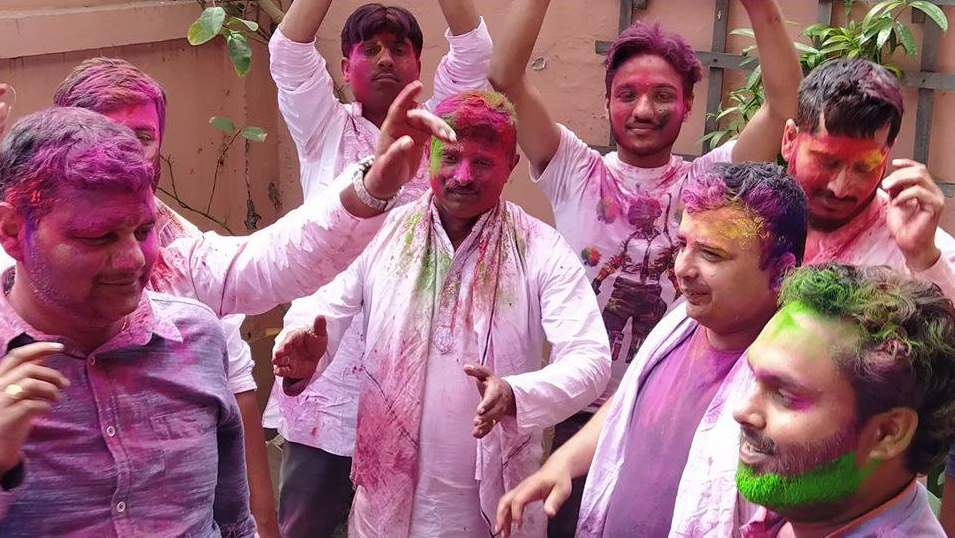The multicolored Chir represents the Kadam tree that Lord Krishna is said to have climbed with the stolen Saris of milkmaids bathing in the Jamuna river. A talented flutist, the legend goes, Lord Krishna used to climb up the tree and play his flute to court his love Radha. With his tune, he would send messages to Radha, asking her to meet him in the Vrindavan forest. It is believed Lord Krishna used to play Holi with Radha and her friends. The great poet of Mithila, Vidyapati, has described this in one of his poems:
Let us go to see Vasant (Spring) Where Ketaki and Kund are laughing The moon is clear The bees are black The night is dim The beloved one is getting angry Kamadev (the god of love) fights with his enemy Radha and Krishna are planning to go out and play in the forest. Merriment and romance are the essence of Faguwa. This festival is related to the full moon as it is supposed to increase the sexual urge not only in adults but also in elderly people. The full moon fills the hearts of revelers with mirth and merriment. Kamadev is supposed to transmit vitality and vigor in all types of people, irrespective of age during this festival, which brings enjoyment to newly-engaged and married couples as well. Cupid comes to life and brings cheers to the monotonous lives of the local people. The whole of Madhes is in a mood of merriment with the feast forming a n important part of the fest. In the Tarai-Madhes, this feast goes on for weeks, where people eat eggs, fish and meat. Non-vegetarian meals are the main source of increasing sexual excitement followed by home-brewed beer. Vegetarian people eat sweets and fruits. The Hindus around the world celebrate Holi marked by mingling of sexes and castes. It is a golden occasion for forgetting the ill will and fostering love, affection and sympathy. “Faldon” (the origin of the word Fagu) in Sanskrit means red powder, Kumkum or Sindur. The first night of the full moon is dedicated to the prayer of the Holi fire, while the second day is considered the day of dust (Dhulikshava), the third day is of Rangotsav, which literally means the festival of colors. The goddess of Holia is invoked on the first day of the fest marked by obscene shouting. Sanskrit scholars explain it thus: The 15th of Falgun Shukla is marked by the Purva Falguni constellation with Bhag as its goddess, meaning the private part through which a child is born. Shouting obscenity is a way of offering prayers to the goddess; it can also be seen as an aboriginal fertility rite. For many, Holi is also a festival to let out pent-up emotions. In Freudian lens, Holi offers an opportunity to express one’s libido, restricted and tabooed the whole year. It is both verbal as well as physical expression of gaiety and unbridled urges. Pauranic origins Bhavishya Purana mentions Falgun as the last month of the Shalvahan Calendar), it is to be observed as the festival to ring in a new year. To quote PB Shelley: If winter comes, can spring be far behind? It is but natural to regard Holi as a spring festival or Vasanttotsav. There is also another Hindu legend concerning Holi, where Lord Shiva opened his third eye in anger to burn down Kamadev, rendering him Anang (bodiless). It is believed that Lord Shiva later restored Kamadev’s life upon requests from Parvati, the constant companion of Lord Shiva. This festival is celebrated every year with pomp and show. Holi or Hori or Faguwa folk songs are melodious and meaningful. Mythological relevance is revealed in the following folk song: On the day Krishna played the flute, The three worlds were connected, What was the flute made of? And how was it tied? On the day, Krishna charmed the world, With bones and flesh and flute was made With love it was tied. This festival, associated with Lord Krishna, Radha, Rama and Sita, Shiva and Parvati, has deep religious significance.











